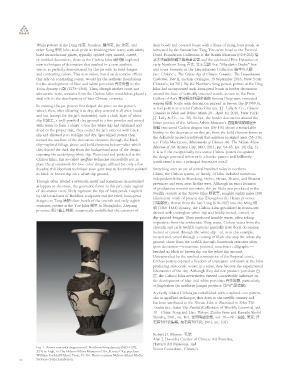Page 92 - Sotheby's New York Linyushanren Part IV Auction September 13, 2018
P. 92
While potters at the Ding 定窯, Yaozhou 耀州窯, Ru 汝窯, and their bowls and covered boxes with a frieze of rising lotus petals, as
other Song 宋代 kilns took pride in fnishing their wares with subtly witnessed by the famous late Tang Yue-ware bowl in the Percival
hued monochrome glazes, typically applied over incised, carved, David Foundation Collection at the British Museum (PDF.262) 倫
or molded decoration, those at the Cizhou kilns 磁州窯 explored 敦大英國博物館大維德基金會 and the celebrated Five Dynasties or
new techniques of decoration that resulted in a new aesthetic early Northern Song 五代, 北宋早期 Yue “Mandarin Ducks” box
vision, as perfectly demonstrated by this jar with its bold designs and cover formerly in the Linyushanren Collection 臨宇山人藏
and contrasting colors. This new vision, based on decorative effects (see: Christie’s, The Classic Age of Chinese Ceramics: The Linyushanren
that rely on contrasting colors, would lay the aesthetic foundations Collection, Part II, auction catalogue, 15 September 2016, New York:
for the development of blue-and-white porcelain 青花瓷器 in the Christie’s, lot 701). By the Northern Song period, potters at the Ding
Yuan dynasty 元朝 (1279–1368). Thus, though neither court nor kilns had incorporated such lotus-petal bands as border decoration
aristocratic ware, ceramics from the Cizhou kilns nonetheless played a around the base of vertically oriented vessels, as seen in the Freer
vital role in the development of later Chinese ceramics. Gallery of Art’s 華盛頓菲利爾美術館 famous Ding-ware truncated
meiping 梅瓶 bottle with decoration painted in brown slip (F1959.6),
In creating this jar, potters frst shaped the piece on the potter’s
as had potters at several Cizhou kilns (see: J.J. Lally & Co., Chinese
wheel, then, after allowing it to dry, they covered it all over, inside Ceramics in Black and White: March 20 - April 10, 2010, New York:
and out (except for the jar’s underside), with a thick layer of white
J.J. Lally & Co., no. 30). In fact, the border decoration around the
slip 化妝土, a well-purifed clay ground to a fne powder and mixed
lower portion of the Nelson-Atkins Museum’s 堪薩斯城納爾遜美
with water to form a slurry. Once the white slip had stabilized and
術館 renowned Cizhou dragon vase (36-116) shows a remarkable
dried to the proper state, they coated the jar’s exterior with black kinship to the decoration on this jar, from the bold chevron forms to
slip and allowed it to stabilize and dry. Specialized potters then
the delicately incised scrollwork that enlivens localized areas (35-116;
incised the outlines of the decorative elements through the black
see: Colin Mackenzie, Masterworks of Chinese Art: The Nelson-Atkins
slip—stylized foliage above and bold chevrons below—after which
Museum of Art, Kansas City, MO, 2011, pp. 64-65, no. 18) (fg. 1).
they shaved the dark slip from the background areas of the design, It is as if the exceptionally innovative Cizhou potters recognized
exposing the underlying white slip. Pioneered and perfected at the
the design potential inherent in a border pattern and brilliantly
Cizhou kilns, this so-called sgraffato technique successfully put in
transformed it into a principal decorative motif.
place the groundwork for two-color designs; utilized for only a few
decades, this laborious technique soon gave way to decoration painted Stretching over an arc of several hundred miles in northern
in black or brown slip on a white slip ground. China, the Cizhou system, or family, of kilns included numerous
independent kilns in Shandong, Hebei, Henan, Shanxi, and Shaanxi
Though often labeled a sawtooth motif and sometimes characterized
provinces and even areas farther west. Although its exact location
as lappets or chevrons, the geometric forms in this jar’s main register of production remains uncertain, this jar likely was produced in the
of decoration more likely represent the tips of lotus petals. Inspired
twelfth century at the Xiuwu kilns 修武窯, roughly eighty miles (100
by the lotus-bases of Buddhist sculptures and the relief, lotus-petal
kilometers) north of present-day Zhengzhou (in Henan province
designs on Tang 唐朝 silver bowls of the seventh and early eighth
河南鄭州). Active from the late Tang (618–907) into the Ming 明
centuries, potters at the Yue kilns 越窯 in Shanglinhu, Zhejiang 朝 (1368–1644) dynasty, the Cizhou kilns specialized in stonewares
province 浙江省上林湖, occasionally embellished the exteriors of
dressed with underglaze white slip and boldly incised, carved, or
slip-painted designs. They produced humble wares, often taking
inspiration from the aristocratic Ding wares. Cizhou wares from the
eleventh and early twelfth centuries generally have foral decoration
incised or carved through the white slip—or, as in this example,
incised and carved through a coating of black slip atop the white slip
ground; those from the twelfth through fourteenth centuries often
sport decoration—sometimes pictorial, sometimes calligraphic—
brushed in black or brown slip on the white slip ground.
Untrammeled by the rarefed conventions of the Imperial court,
Cizhou potters enjoyed a freedom of expression unknown at the kilns
producing aristocratic wares; in a sense, they became the experimental
laboratories of the day. Although they did not produce porcelain 白
瓷, the Cizhou kilns nevertheless exerted considerable infuence on
the development of blue-and-white porcelain 青花瓷器, particularly
at Jingdezhen (in northeast Jiangxi province 江西省景德鎮).
A closely related Cizhou jar embellished with a stylized coin pattern,
also in sgraffato technique, that dates to the twelfth century and
-
has been attributed to the Xiuwu kilns is illustrated in Sekai Toji
-
-
-
Zenshu (see: Sekai Toji Zenshu [Collection of World’s Ceramics], vol.
10—China: Song and Liao, Tokyo: Zauho Press and Kawade Shobo -
Shinsha, 1961, no. 101. 世界陶磁全集, vol. 10—宋・遼篇, 東京: 座
右寶刊行会編輯, 座右寶刊行会, 1961, no. 101).
Robert D. Mowry 毛瑞
Alan J. Dworsky Curator of Chinese Art Emeritus,
Harvard Art Museums, and
Fig. 1. Flower vase with dragon motif, Northern Song dynasty (960-1127), Senior Consultant, Christie’s
22 ¡ in. high, in The Nelson-Atkins Museum of Art, Kansas City, purchase:
William Rockhill Nelson Trust, 35-116. Photo courtesy Nelson-Atkins Media
90 Services / John Lamberton.

